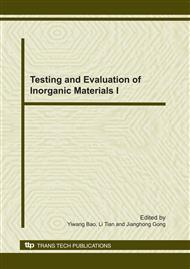p.382
p.386
p.390
p.394
p.398
p.404
p.407
p.411
p.415
Zinc Oxide Thin Films Grown by RF Magnetron Sputtering on Nanostructure Al Thin Layer/Glass and Glass Substrates
Abstract:
ZnO films with random and highly (002)-preferred orientation were deposited on nanostructured Al (n-Al) /glass and glass substrates at room temperature by RF magnetron sputtering method, respectively. According to I (002)/I (100) ≈I annealed (002)/I annealed (100) ≈1.1 (on n-Al) and 2I annealed (002) /I (002) (on n-Al) ≈ I annealed (002) /I (002) (on glass) ≈3.1, the rough n-Al surface is suitable for the growth of a-axis orientation, and the appearance of the (100) peak plays a major role in decreasing the c-axis orientation. The average optical transmission of the film on n-Al layer increased significantly after annealing. At the same time, the growth mode and E g of ZnO films were discussed. On n-Al layer/glass substrate, it is not easy for the growth interface to form the smooth surface during the deposition process and Stranski Krstanov plays a primary role on the deposition of the films. Due to the significant increase of the interplanar spacing d (101), the band gaps for as-grown and annealed films grown on n-Al decreased, comparing with that of the film deposited on glass substrate.
Info:
Periodical:
Pages:
398-403
Citation:
Online since:
December 2010
Authors:
Keywords:
Price:
Сopyright:
© 2011 Trans Tech Publications Ltd. All Rights Reserved
Share:
Citation:


